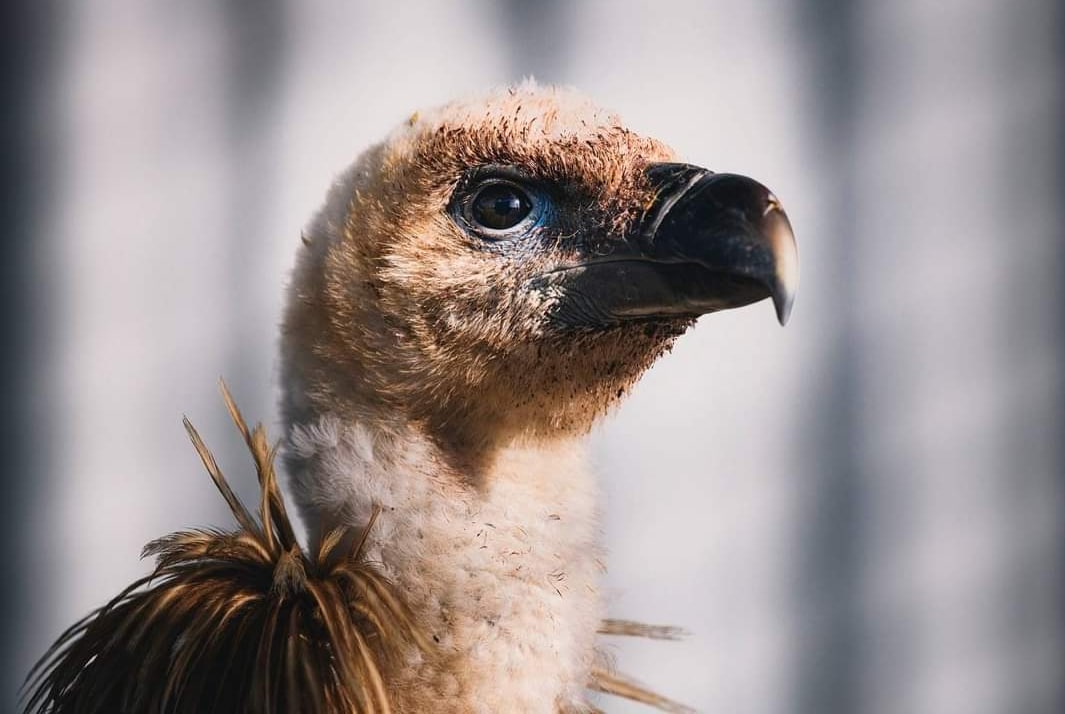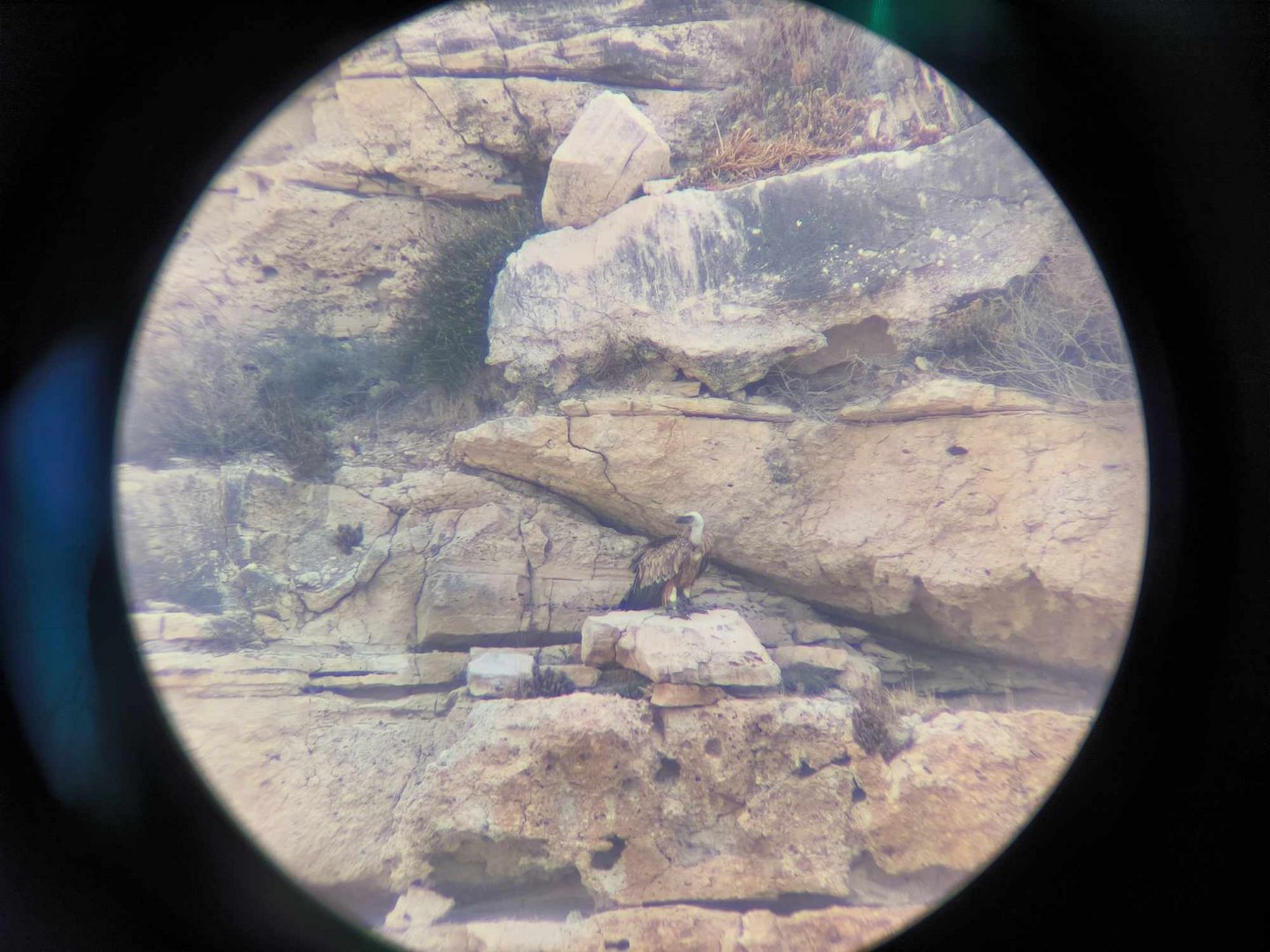Nearly time to breed: the ‘LIFE with Vultures’ project is slowly gaining ground
The first days of the New Year bring hope in a rather odd form: a lighter shade of brown.
This shade – suggesting a definite shift towards white – is seen from afar on the long feathers forming the ‘ruff’ round the base of a Griffon vulture’s neck. We spot this through a scope, viewing a bird sat safely out of harm’s way on a ledge on a high cliff, while doing a vulture survey at the top end of the remote Xeros Valley, Paphos area.
This lighter shade brings great joy to our vulture project team. Smiles all round. A case of ‘clutching at feathers’, you might think. But no, this ‘shade-shift’ is actually tangible and very welcome evidence that this particular vulture is growing up and could breed in the near future.
To explain, on younger birds, the ruff feathering around the neck is brown. On birds reaching breeding age it is white, and this is one of the easier ways to age vultures in the field. The ruff on the bird in question was not pure white, but clearly much paler than the brown ruff on the other vultures perched nearby on the cliffs. It takes Griffon vultures a full five or six years to reach adulthood, so this bird-of-lighter-ruff was perhaps three years old. Which means it is getting there. It could be nest building by this time next year (vultures start the long process of raising their one chick early in the year). It also means this is one of our oldest remaining Griffon vultures.
With our vulture population at such a perilous low, and with the birds brought in from Spain to bolster numbers being so young, the value of older birds in the local population cannot be overstated. To get to breeding age, to the point where they can contribute new members to the local population, the Spanish birds need to survive threats like poisoning and collision with power cables for another four or five years.
We will of course do everything we can to ensure the new birds from Spain go the distance. Every single one of the birds arriving by jet from Spain now gets fitted with a purpose-designed satellite tag. This enables the ‘LIFE with Vultures’ project team to keep a very close eye on them. Any abnormality in movements is, thanks to this satellite coverage, swiftly picked up by the team and a field team is dispatched to check. We have saved quite a few birds this way in recent months, I am happy to report. The Game & Fauna Service – key partners to BirdLife Cyprus on ‘LIFE with Vultures’ – have been at the forefront of this, but others have played their full part in vulture rescues. A real joint effort to ensure no bird is lost in the battle to save our most threatened bird species.
There are currently 15 young vultures, flown in from Extremadura a month ago, acclimatising in a large holding aviary in a remote and closely guarded site in the Limassol hills. They will be released to join and boost the local population, most of which also came from Spain, in a few months. A big thank-you is once again due to the Extremadura authorities for this ‘injection of hope’, to the Vulture Conservation Foundation for coordinating the transport and to the EU LIFE fund for contributing to the costs of translocation acclimatisation.
Nonetheless, older Griffon vultures are at an absolute premium in Cyprus and very valuable in the shorter-term.
Back to the Xeros survey site, and there more broad smiles – the odd ‘whoop’ of joy, even – among the watching humans. The vigil at the cliffs has managed to pick out the code on the leg ring on the bird-of-lighter-ruff. This confirms what we had already suspected and hoped. The gorgeous specimen we are watching is none other than ‘Costis’. Hatched in March 2020, in a nest on cliffs on the edge of the Paphos forest, Costis has since become a particular favourite of the ‘LIFE with Vultures’ crew.
Costis began life the hard way, and very nearly did not make it. Just a few weeks after his maiden flight, he was found exhausted and bone-thin in the Diarizos valley. When rescued, he weighed a mere 4 kilos, a good 3 kilos short of the ideal for a young vulture. It took two months of careful and patient care to get Costis back to health – special mention must go here to the excellent work of local wildlife vet Constantinos Antoniou. Costis the vulture is named after his saviours, Costas the health department officer who found him and Constantinos the vet.
Recovered, the young vulture was released again and the satellite tag on his back tells us he has been doing well since, joining the other near-30 vultures in roaming the skies between Episkopi and the remote Ha Potami, Xeros, Diarizos and Ezousas valleys.
Costis has steered clear of the collision and electrocution dangers posed by power lines, pylons and aerial masts. He has avoided the dreadful poisoning incidents that have cut short the lives of 14 of his kin in recent times. We are making definite progress in tackling both these key threats, but the truth is it will take time and, above all, persistence. Safe food is being provided in a growing network of vulture ‘restaurants’ and we are working with the Electricity Authority to mark power cables, making them easier for vultures (and eagles) to avoid.
Great though it is to have technological data showing healthy flight patterns, there is just no substitute for seeing Costis in the field. Up there on the high cliffs, doing what vultures do with his new friends from Spain. Preening and making short flights on those huge wings, in preparation for a day of wandering the skies. It is heartwarming stuff, and makes for a good start to 2024.
Our hope is that the worst that will befall Costis from here on in is our discovering he is a girl and not a boy vulture, and has to ‘suffer’ a name change! (Vulture sex cannot reliably be determined in the field). Either way, the hope is he/she will pair up and will be nest-building by this time a couple of years down the line, and for many years after that…
Martin Hellicar is director of local nature conservation NGO BirdLife Cyprus









Click here to change your cookie preferences